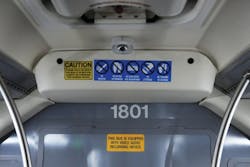Of all of the vertical markets in security, mass transit is perhaps one of the most challenging environments in terms of securing physical assets and people. Not only do end users in this market have to account for a constant flow of people into and out of rail and bus terminals, but they are also responsible for keeping passengers safe in transit. Designing, installing and maintaining a video system on this scale takes an incredible amount of coordination between the end user, integrator and their respective technology partners. Additionally, many people have found that trying to get all of this technology to be interoperable and integrated into a common operating picture to be a near impossibility. But this is exactly what Nice Systems has been able to help the Denver Regional Transportation District (RTD) accomplish through an innovation in their NiceVision video management system that enables them to take their fixed platform and extend it out to mobile assets.
“We’ve really created something brand new and fresh from a Nice perspective in terms of the integration that allows us to extend to those mobile assets,” said William Lafave, regional vice president, major accounts, for Nice’s security group. “What we’re leveraging is the tried and true platform that we’ve had in operation in the NiceVision solution and NICE Inform audio solution at RTD.”
Lafave, along with Bob Grado, RTD Transit police commander and manager of integrated security operations, sat down with SIW at this week's ISC West conference to discuss the project in detail.
Grado said that as of two years ago, RTD was using three different mobile platforms, all of which were analog and described as troublesomely inefficient.
“For one, we had to go pull hard drives at night and we do 6,000 video investigations every year. So, each night while we’re at home sleeping, we’ve got folks out there pulling hard drives off of buses that have been queued up for a video investigation,” said Grado.
Realizing that this was unsustainable, Grado said they sought out a solution that would make using video surveillance more seamless at RTD, which is one of the largest transit authorities in the country, spanning eight counties, 44 cities and 2,400-square-miles.
“Our Nice platform, our VMS in our command center where we’re operating thousands of cameras that we can see from there, has always been a very stable, flawless and very simple to operate,” said Grado. “The dream was, if you will, to take this moving into the mobile world and be able to connect from that command center if we have to, in an emergency or for whatever reason. We presented the idea to Nice and said, ‘hey, what do you guys think?’ ‘We’re going to take this to market because we want to do this.’ Our hope was to make it work with Nice, but because we’re a competitive environment with government, we put it out to four companies.”
However, Grado said that Nice was the only vendor that was able to get the system to work properly. The project is taking place in phases right now, according to Grado, who also said that they’re currently in the process of replacing half of their bus fleet.
“The goal was to not worsen our current problem and put analog and older technology in brand new buses,” said Grado. “After a lot of work over two years we’re up and running now.”
Because the new streamlined mobile video system is digital, Grado said that they’re getting between two to three times more storage capabilities, high resolution video images and the ability to integrate with routers that reside on their buses and trains in the near future.
In addition, Grado said that they’ve received support from management for this project.
“Our upper-level management from the CEO on down has allowed us to invest heavily in this technology because we rely on it so much,” Grado explained.


